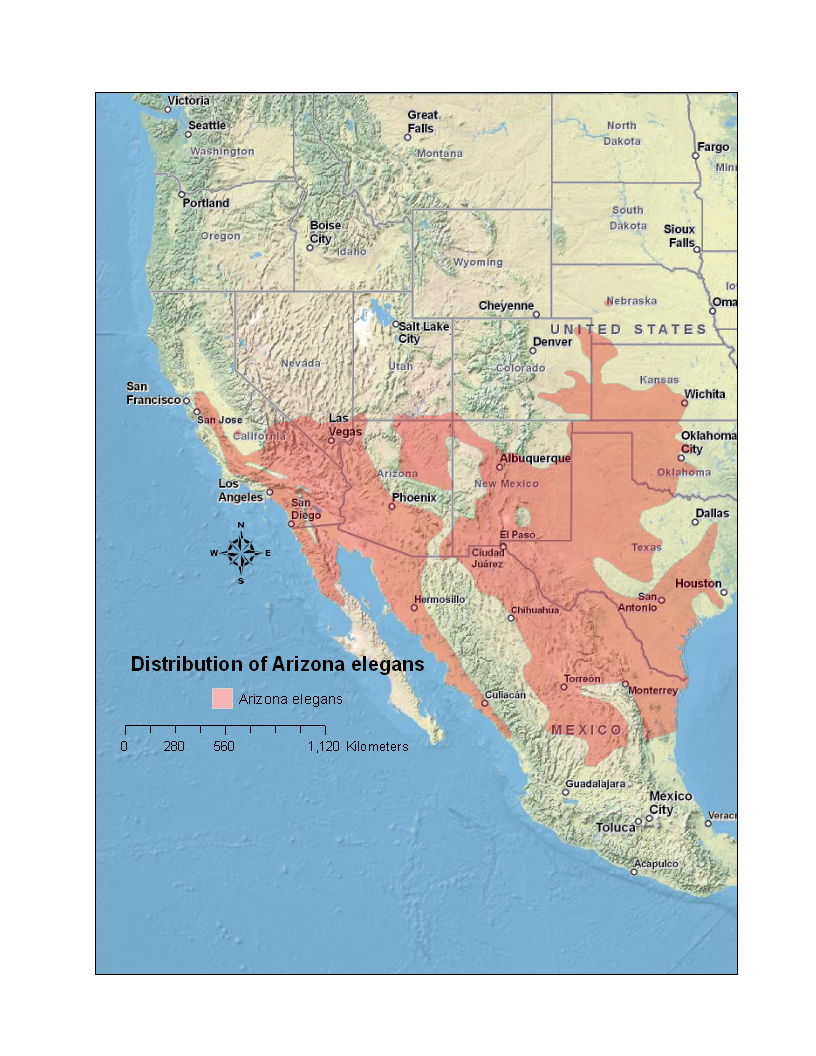Arizona Elegans on:
[Wikipedia]
[Google]
[Amazon]
''Arizona elegans'' is a
 Habitat is normally semi-arid grasslands of the southwestern United States, from California in the west to Kansas in the east and as far south as Texas, and northern Mexico.
Habitat is normally semi-arid grasslands of the southwestern United States, from California in the west to Kansas in the east and as far south as Texas, and northern Mexico.
Arizona elegans
at The Reptile Database {{Authority control Colubrids Reptiles of Mexico Reptiles of the United States Snake, Glossy Snake, Glossy Reptiles described in 1859
species
In biology, a species is the basic unit of classification and a taxonomic rank of an organism, as well as a unit of biodiversity. A species is often defined as the largest group of organisms in which any two individuals of the appropriate s ...
of medium-sized colubrid
Colubridae (, commonly known as colubrids , from la, coluber, 'snake') is a family of snakes. With 249 genera, it is the largest snake family. The earliest species of the family date back to the Oligocene epoch. Colubrid snakes are found on ev ...
snake
Snakes are elongated, limbless, carnivorous reptiles of the suborder Serpentes . Like all other squamates, snakes are ectothermic, amniote vertebrates covered in overlapping scales. Many species of snakes have skulls with several more j ...
commonly referred to as the glossy snake or the faded snake, which is endemic
Endemism is the state of a species being found in a single defined geographic location, such as an island, state, nation, country or other defined zone; organisms that are indigenous to a place are not endemic to it if they are also found else ...
to the southwestern United States and Mexico. It has several subspecies. Some have recommended that ''A. elegans occidentalis'' be granted full species status.
Subspecies
Subspecies of ''Arizona elegans'' include: * '' Arizona elegans arenicola'' Dixon, 1960 – Texas glossy snake * '' Arizona elegans candida'' Klauber, 1946 – Western Mojave glossy snake * '' Arizona elegans eburnata'' Klauber, 1946 – Desert glossy snake * '' Arizona elegans elegans'' Kennicott, 1859 – Kansas glossy snake * '' Arizona elegans expolita'' Klauber, 1946 – Chihuahua glossy snake * '' Arizona elegans noctivaga'' Klauber, 1946 – Arizona glossy snake * '' Arizona elegans occidentalis'' Blanchard, 1924 – California glossy snake * '' Arizona elegans philipi'' Klauber, 1946 – Painted Desert glossy snakeDescription
The glossy snake and its many subspecies are all similar in appearance togopher snake
''Pituophis'' is a genus of non venomous colubrid snakes, commonly referred to as gopher snakes, pine snakes, and bullsnakes, which are endemic to North America.
Geographic range
Species and subspecies within the genus ''Pituophis'' are found t ...
s. However, they are smaller than gopher snakes, with narrow, pointed heads, and a variety of skin patterns and colors. They appear "washed-out" or pale, hence the common name, "faded snakes".
Most subspecies are ca. 75–130 cm (ca. 30-50 inches) in total length. The maximum recorded total length for the species is 142 cm (56 in). Smith, H.M., and E.D. Brodie Jr. 1982. ''Reptiles of North America: A Guide to Field Identification''. Golden Press. New York. 240 pp. (paperback). (''Arizona elegans'', pp. 182-183.)
They are shades of tan, brown, and gray with spotted patterns on their smooth, glossy skin, and a white or cream-colored unmarked ventral
Standard anatomical terms of location are used to unambiguously describe the anatomy of animals, including humans. The terms, typically derived from Latin or Greek roots, describe something in its standard anatomical position. This position prov ...
surface. Coloration often varies in relation to the color of the soil in a snake's native habitat.
Habitat
 Habitat is normally semi-arid grasslands of the southwestern United States, from California in the west to Kansas in the east and as far south as Texas, and northern Mexico.
Habitat is normally semi-arid grasslands of the southwestern United States, from California in the west to Kansas in the east and as far south as Texas, and northern Mexico.
Behavior and diet
They are nonvenomous, nocturnalpredators
Predation is a biological interaction where one organism, the predator, kills and eats another organism, its prey. It is one of a family of common feeding behaviours that includes parasitism and micropredation (which usually do not kill th ...
of small lizards.
Reproduction
Glossy snakes are oviparous. Adults breed in the late spring and early summer. Clutches average from 10 to 20egg
An egg is an organic vessel grown by an animal to carry a possibly fertilized egg cell (a zygote) and to incubate from it an embryo within the egg until the embryo has become an animal fetus that can survive on its own, at which point the a ...
s. The eggs hatch in early summers and the newly hatched young are approximately in total length.
References
Further reading
* Kennicott, R. ''in'' Baird, S.F. 1859. United States and Mexican Boundary Survey, under the Order of Lieut. Col. W. H. Emory, Major First Cavalry, and United States Commissioner. Reptiles of the Boundary, with Notes by the Naturalists of the Survey olume 2 United States Government. Washington, District of Columbia. 35 pp. + Plates I.- XLI. (''Arizona elegans'', pp. 18–19 + Plate XIII.) * Klauber, L.M. 1946. The Glossy Snake, Arizona, with Descriptions of New Subspecies. ''Transactions of the San Diego Society of Natural History'' 10 (17):311-398.External links
* *SpecieArizona elegans
at The Reptile Database {{Authority control Colubrids Reptiles of Mexico Reptiles of the United States Snake, Glossy Snake, Glossy Reptiles described in 1859